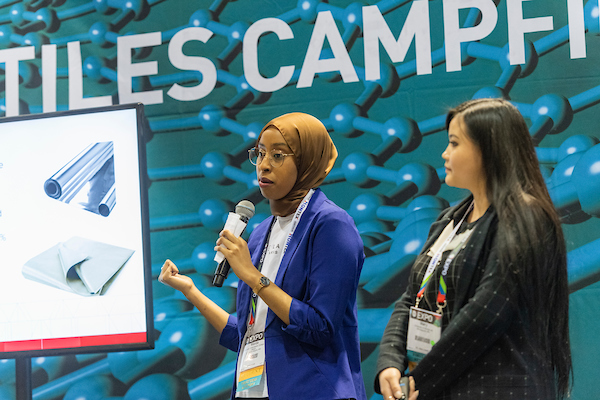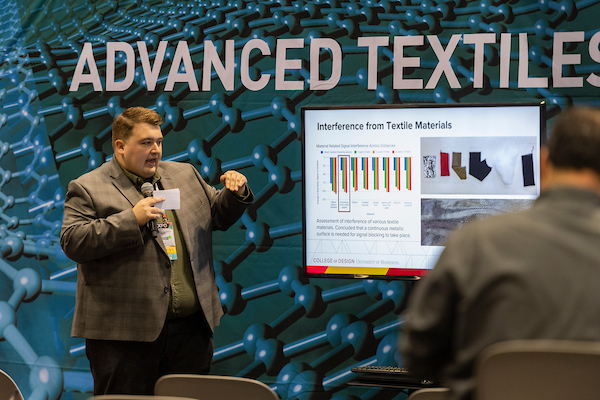Emerging Technologies Conference registration is an additional add on to Advanced Textiles Expo, Nov. 5–7.
Kick off your week at the Emerging Technologies (ET) Conference on
Tuesday, Nov. 4—an exclusive day packed with innovative education and
networking opportunities. Then, the Advanced Textiles Expo begins on
Wednesday, Nov. 5, featuring additional emerging technologies education
on the show floor and can’t-miss experiences. Expo concludes on Friday, Nov. 7.
|
Tuesday, Nov. 4 |
|
| 9–9:50 am |
Medical Products vs. Medical Devices
Room 139 Dr. Alexander Laubach, Head of Business Development for Medical Technologies & Biocompatibility, Hohenstein Laboratories What’s the difference between a healthcare product and a medical device? How are they regulated and what claims can you make? Compliance with the EU Medical Device Regulation (MDR) and the U.S. FDA requirements for medical devices can be complicated – and avoiding medical claims on consumer products is just as important. We’ll discuss the requirements for both, focusing especially on biological safety and performance. |
|
Lyocell from Hemp: A Journey from Concept to Production Reality
Room 140 Lelia Lawson, Founder and CTO, Zylotex Inc This session explores the early-stage challenges and breakthroughs in scaling lyocell manufacturing using hemp as a sustainable feedstock. Drawing from real-world experience, we’ll examine the technical, logistical, and market-related hurdles that arise when introducing innovative materials into established production systems. The presentation will highlight the critical role of collaboration, persistence, and adaptive problem-solving in advancing sustainable textile solutions. Attendees will gain practical insights into the potential of hemp-based lyocell and the broader implications for the future of eco-conscious manufacturing. Learning Objectives:
|
|
| 10–10:50 am |
Circular Thermoregulating Textiles: Protecting Agricultural Workers from Extreme Heat
Room 139 Dr. Cindy Cordoba, Assistant Professor, California State Polytechnic University, Pomona Agricultural workers face extreme heat exposure, increasing the risk of heat stress and reducing productivity. This session explores the development of thermoregulating textiles designed to enhance worker safety while incorporating circular design strategies. The presentation will highlight material selection, modular design for extended use, and system-based approaches to improve heat resilience in agricultural workwear. Attendees will gain a deeper understanding of circular strategies applied to functional apparel and their role in advancing sustainable worker protection solutions for extreme heat environments.
|
|
Reweaving Skills: Harnessing AR/VR to Empower Next-Gen Operators
Room 140 Jonathan Crumpler, Assistant Dean, Business and Technologies Division at Western Piedmont Community College; Tom Wright, Lead developer on the NC Textiles Innovation and Sustainability Engine Join two leading AR/VR developers as they reveal how immersive simulations are revolutionizing operator training in textile manufacturing. You’ll see real-world demos, learn best practices for reducing onboarding time and boosting retention, and discover how these cutting-edge tools attract digital-native talent. Don’t miss this deep-dive into the future of workforce development—where ancient craft meets tomorrow’s technology. |
|
| 11–11:50 am |
Revitalizing the Textile Industry Through the Textile Innovation Engine of North Carolina
Room 139 Bailey Smith, Extension Coordinator, Zeis Textiles Extension in NC State University’s Wilson College of Textiles The textile industry is experiencing a transformation, and North Carolina is at the heart of this movement. In this forward-looking session, key partners will unveil how the Textile Innovation Engine of North Carolina is driving a new era of growth, innovation, and market leadership. Attendees will gain insights into how cross-sector collaboration, applied research, and cutting-edge manufacturing approaches are positioning the region as a global powerhouse for advanced textiles. From reshoring opportunities to workforce development, from sustainable production models to breakthrough applications in healthcare, defense, and consumer markets, the Textile Innovation Engine is more than a regional initiative; it’s a blueprint for revitalizing the industry as a whole. Whether you are a manufacturer seeking a competitive advantage, a brand looking to integrate smart or sustainable textiles, or a stakeholder optimizing supply chains, this session will spark ideas, reveal actionable partnerships, and provide a roadmap for staying ahead in today’s rapidly evolving landscape. |
| 11:50 am–12:45 pm | Emerging Technologies Conference Lunch |
| 12:45–1:35 pm |
Advanced Textile Technologies: Pushing the Boundaries for Dual Use Applications
Room 139 Michael Rein, Ph.D., Director of Engineering, AFFOA Join AFFOA’s Director of Engineering, Michael Rein Ph.D. to learn about AFFOA’s advancements and collaborative development of e-textile products and tools for advanced textile manufacturing to enable next-generation military and commercial applications. During the presentation you will see examples of advanced fabric technologies developed to increase safety, comfort, and emergency readiness with vast potential to be commercialized and improve lives. Learn about:
|
|
CANCELLED: Nasa’s Development of Next-Generation Lunar Space Suit Fabrics
Note: NASA sessions cancelled due to government shutdown. Robert Jones, Pressure Garment Engineer, Space Suit and Crew Survival Systems Branch, NASA Johnson Space Center Learn about NASA’s development of next-generation Lunar space suit fabrics focusing on optical properties and lunar dust resistance. This session will educate the industry on space suit technology, explain technological challenges associated with space suit textile development and identify material characteristics that are most important when designing suit materials. |
|
| 1:40–2:30 pm |
Advancing Cotton for Performance Textiles: Bio-Based, Low-Temperature Preparation Pathways
Room 139 Hasan Shahariar, Director of Product Commercialization, Fibre52 New bio-based, low-temperature alternatives are enabling cotton to perform at higher levels in technical and performance applications, from apparel to industrial and medical textiles. This session examines the science behind these processes, focusing on fiber strength retention, dye uniformity, and compatibility with blends and finishes common in performance markets |
|
Infrared-Responsive Textiles: Advancing Functionality for All Seasons
Room 140 Akira Kumada, Product Manager, High-performance Product Development/Sales Sec., TAKISADA-NAGOYA CO.,LTD. This session will introduce a novel approach to infrared (IR) absorbing technology in yarns and textiles, developed through the application of rare metal–derived nanoparticles. Unlike conventional materials, this technology interacts with near-infrared light in ways that enable new functional properties for fabrics. Attendees will learn how IR-responsive textiles can:
By exploring the science behind these capabilities, the presentation will highlight how infrared technologies may expand the possibilities for functional fabrics in apparel, protective wear, and beyond. |
|
| 2:40–3:20 pm |
The Next Small Steps: Creating the Artemis Lunar Boots
Room 139 Morgan Campbell, Soft Goods Developer, David Clark Company At the intersection of Design and Engineering sits Innovation: more than 50 years after the last human set foot on the Moon, a new era of space exploration, the Artemis Expeditions, carry the legacy of Apollo and the spirit of Gemini. A new group of astronauts, engineers, designers, and technicians is working to return humanity to the Moon, exploring more of its surface than ever before. These next steps will be taken wearing a pair of Artemis Lunar Boots. What does one wear while exploring the dark side of the Moon? What materials are best suited to an entirely alien environment? This presentation will explore the unique demands of lunar exploration from micrometeoroids to moon dust and the fabrics that make the mission possible. The Lunar Boot Environmental Protection Garment (EPG) and Outsole are responsible for shielding and insulating the astronaut’s feet as they traverse a surface which, in some areas, has never been touched by the Sun. Beginning with the protective outer layer which provides strength, puncture resistance, and dust resistance; followed by layers of insulation; and a lining layer that provides strength, stability, and puncture resistance; the EPG is designed to keep the astronaut comfortable and safe without compromising functionality whilst conducting Moonwalks. Each material was selected to solve a specific set of problems, culminating in a piece of soft equipment capable of withstanding an environment unlike anything found on Earth. |
| 3:20–3:35 pm | Break |
| 3:35–4:25 pm |
Valorizing Waste and the BioMaterial Revolution
Room 140 Thomasine Dolan Dow, Thomasine Dolan Consulting, Sustainable Next-Gen Innovation+Design Valorizing waste to create BioMaterials is revolutionizing the sustainable materials and performance coatings landscape. Not since the 1940s have we seen so much activity in material science. By transforming agricultural and food industry waste, textile waste, and tapping natural resources like seaweed, algae and mycelium into high-performance fibers, we are getting closer to building a roadmap for a circular economy. This is an opportunity to explore the next generation of sustainable innovation in textiles, materials and performance coatings. You will learn about:
|
| 4:35–5:25 pm |
Panel Discussion | AI in Everyday Business: Real-World Use Cases from Industry Leaders
Room 139 Moderator: Paige Mullis, Senior Sales Executive, MMI Join a dynamic panel where industry leaders reveal how AI is revolutionizing daily workflows—from marketing and design to sourcing, manufacturing, and product development. Moderated by Paige Mullis, you’ll hear real-world case studies and walk away with actionable strategies for integrating AI tools to boost efficiency, spark innovation, and gain a competitive edge. |
| 5:30–6:30 pm |
Emerging Technologies Conference Networking Reception
Join fellow Emerging Technologies (ET) Conference attendees and speakers for a closing reception with drinks and hors d’oeuvres, an ideal way to network and unwind after a full day of innovation and insights. |
Advanced Textiles Expo 2025 includes exhibit hall space for ET innovators, suppliers, beginners and experts. Get inspired, make connections, discuss opportunities and find new products. Join over 75 vendors, associations, and ATA partners in this vibrant pavilion.
Looking for show floor education? Advanced Textiles Expo 2025 will feature interactive sessions right on the show floor in the dedicated education booths! Stop by for fun, informal, and digestible sessions and keep the conversation flowing back to the exhibitor booths.



Emerging Technologies Council – ETC serves as the principal international resource providing members with the most current information on research, best practices and innovative knowledge available to advance emerging technologies within materials, products, processes and more. For more information on ETC, click here.
“Having now visited ATA shows for more than 5 years, I’d like to share with you our excitement and satisfaction during this year’s show. This year was particularly effective for us, as we had several opportunities to share our public funded research results with interested public.”
Andreas Bisinger
DITF–German Institutes of Textile and Fiber Research, Germany

Contact Us